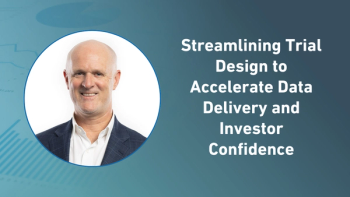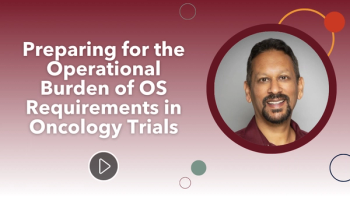
- Applied Clinical Trials-06-01-2008
- Volume 0
- Issue 0
Workload Measurement
How one workload study measured tasks, time, and resources necessary to run a cancer clinical trial today.
Clinical trials as a means of informing evidence-based medicine are routine practice in many oncology departments. The emphasis on efficient use of resources, rising costs of clinical trials, use and complexity of multimodality treatment regimes, regulatory requirements, and quality assurance have resulted in a greater focus on workload issues relating to participation in clinical trials. This has led to a need to accurately assess the impact of these issues through a detailed workload analysis.
PHOTOGRAPHY: GETTY IMAGES
In the absence of reliable published data on workload measurement, departments have introduced clinical trials without due consideration of the workload involved or have used unproven methods for determining capacity. This results in unrealistic performance expectations, excessive workload, and/or inefficient use of resources and is unacceptable. It is therefore essential to gain a better understanding of the tasks involved, the time requirements, and the resources necessary for a department to set up or participate in a clinical trial.
In this context, the European Organization for Research and Treatment of Cancer (EORTC) initiated a project to develop a workload measurement instrument (WMI) to enable centers to accurately record time spent on the different activities and, if desired, use the information to calculate the real cost of recruiting subjects to oncology trials.
Analysis and measurement
The definition of workload analysis is the measurement of the length of time it takes to complete a series of tasks and how frequently they are performed in order to objectively determine staffing requirements for this series of tasks.1
Evidence indicates that a reliable instrument should be developed to facilitate the measurement of the workload involved for centers participating in clinical trials. This view is supported by Roche et al., who stated that a WMI should be developed identifying all the main and subtasks involved in the trial process, covering single and continuous tasks from beginning to end and be nonprofession specific.2
Previous workload measurement studies only related to measuring general nursing tasks and scheduling of radiotherapy treatments. While these are valuable, they were of limited use in the clinical trials context. At the time this project was undertaken, the number of studies specific to workload measurement in clinical trials was limited1-7 and focused, in general, on main tasks and single events.
As no instrument existed that met all the requirements for use in clinical trials, we developed a WMI consisting of four modules to enable individual centers to identify the main and subtasks. These tasks relate to the implementation of clinical trials that are additional to the routine care/treatment of cancer patients. One of the main problems is the definition of routine care, which can vary significantly. It was, therefore, accepted that routine care was in place, so the focus of this project was on the additional work generated as a direct result of the clinical trial.
Six-stage breakdown
The WMI was developed in seven stages. This article describes the first six of these stages.
1. Development of the draft checklist: The first stage involved the production of a comprehensive list of all activities (main tasks and subtasks) integral to the research process.
2. Validation of the draft checklist: The second stage involved circulation to a small group of oncology centers where personnel reviewed the checklists to ensure that all the activities carried out had been included. Advice from the EORTC was given.
3. Revision of the draft checklist: The third stage involved reviewing the suggestions and comments submitted and revising the final checklist accordingly. Given the input to the first three stages, it was felt that the checklist was comprehensive, reflective of all disciplines, and applicable in any country or oncology department.
4. The workload measurement instrument: During the fourth stage, the checklist was reviewed and the steps involved in the research process subdivided and revised to produce the final four modules of the WMI.
5. Feasibility/pilot study. The pilot study was carried out in three departments to evaluate the four modules for ease of completion, clarity, inclusion of all relevant information, applicability, and usefulness. Research radiographers, nurses, and data managers documented the time spent on each main and subtask, recording both single and continuous events (see Table 1). The pilot study ran over six months and modules were completed on a range of trials and tumor sites.
Table 1: Staff identified their roles in the trial, providing a time table for tasks performed and any comments they had.
6. Analysis of the pilot study. Most participants made suggestions with regard to the structure and format of the pilot WMI, and these were analyzed and incorporated into the final WMI. The original, single box per task format was revised to allow for flexibility and reflect when several staff members were involved in a task, and the original "Comments" column was replaced with "Any Additional Comments on Activity" column.
The original column to identify the staff discipline used a tick box. This was revised to "Job Title/Role Within Trial" in order to be nonprescriptive and allow more than one individual to complete the instrument (see Table 2).
Table 2: Feedback provided produced a more flexible checklist to account for all staff members involved in a task.
Module related tasks
The revised main and subtasks for the four modules, identified as part of the pilot project, are outlined:
Module 1: The planning stage. It is to be completed for each new protocol in the planning stage, incorporating all the administrative and coordinating activities carried out from the time of receiving the protocol to subject recruitment.
Protocol evaluation and preparation of submissions
- Reading the protocol
- Initial assessment of feasibility by the research team
- In-house meetings to assess feasibility of the trial
- Preparation of trial documentation and submission to Ethics Committee
- Preparation of trial documentation and submission to Research and Development Department
Meetings and training
- Working party and steering committee meetings
- External investigator meeting
- In-house meetings for information and training
- Organize and hold a trial setup meeting
Financial agreements/Clinical Trial Agreement (CTA)
- Identify and record cost variables
- Meetings with partners for preparing contract/CTA
- Organize CTA (insurance/trial indemnity arrangements)
Administrative and IT preparations
- Preparation of investigator and trial site file
- Collection and filing of study specific documents
- Development of study specific paperwork
- Coordinate and ensure sufficient drug supplies
- IT preparation
Module 2: The implementation stage. This stage is to be completed for every subject considered eligible to enter into a trial, commencing with enrollment and continuing until closure. It includes the time involved in all tasks following the identification of potential clinical trial subjects.
Identify potential trial subjects and screen for eligibility
- Plan additional tests according to protocol requirements, obtain results, and check eligibility
- Document eligibility/noneligibility in screening log, notes, and database
- Contact trial center/chief investigator to check eligibility
Informed consent procedures
- Discuss trial with patient and give out information sheet/consent form
- Additional face-to-face contact with patients to clarify trial participation
- Additional telephone contact with patients to clarify trial participation
- Provide and document continuous psychological support to the subject
Randomization/registration
- Enter trial details into subject's medical file
- Prepare subject's medical file with study-related documents
- Update subject tracking system, logs, and databases
Subject care
- Organize protocol-related appointments and investigations, and inform subject and staff
- Organize protocol-related treatments and visits, and inform subject and staff
- Organize protocol related investigations, and inform patient and staff
- Coordinate and ensure sufficient drug supplies
- Explain, dispense, collect, and check subject's diary
Module 3: Trial data management. To be completed for each protocol during the trial data management stage to document the time spent on administrative issues related to the data management of a specific trial. Starting during the implementation stage, continuing during follow-up, and ending at trial closure.
Monitoring/audit visits
- Plan and prepare for monitoring and audit visit
- Collect subject files/notes for monitoring and audit visit
- Participate in external/internal monitoring and audit visit
- Resolve queries postmonitoring and postaudit visit
Protocol amendments
- Prepare and submit protocol amendments
- Update study documents following amendments
- Participate in in-house meetings to discuss amendments
- Subsequent training following study amendments
Financial management
- Review of financial arrangements
- Raise and invoice
Module 4: The closure/final stage. Completed for each protocol during the closure/final stage when the follow-up of all subjects has been completed, the data files are cleaned, results are collected, feedback given, and no further queries are expected. This stage is administrative and describes the time to assure proper filing/archiving and documentation of a specific trial.
Procedures for closure of the study
- Inform the national authorities
- Inform local authorities
- Review trial documents prior to archiving
- Collect study specific study documentation
- Pack and label study materials for archiving
- Organize drug return and drug destruction
- Organize final shipment of study specific samples
Conclusion
We have developed a complete, usable Workload Measurement Instrument and evaluated this in the European oncology clinical trial setting. The WMI has wide generalizability and is applicable in the nononcology setting as well as outside Europe. The final WMI will now be used in stage seven: the prospective study, which will be a pan-European collaboration with the National Cancer Research Network and EORTC.
Acknowledgements
We would like to thank the EORTC, who supported this work; C. Molin, A. Marinus, and P. Di Guilio, who were participants in the original development; and pilot study participants L. Alder, J. Evans, D. Kumar, E. O'Shea, S. Rolfe, C. Walker, and J. Worville.
Julie Berridge * is Mid Trent Cancer Research Network Manager, Mid Trent Cancer Research Network, Old School of Radiotherapy, Nottingham University Hospitals NHS Trust, Hucknall Road, Nottingham, NG5 1PB, UK, email:
*To whom all correspondence should be addressed.
References
1. R.B. Medvec, "Productivity and Workload Measurement in Ambulatory Oncology," Seminars in Oncology Nursing, 10, 288-295 (1994).
2. K. Roche, N. Paul, B. Smuck et al., "Factors Affecting Workload of Cancer Clinical Trials: Results of a Multicenter Study of the National Cancer Institute of Canada Clinical Trials Group," Clinical Oncology, 20 (2) 545-556 (2002).
3. E. Oddone, M. Weinberger, A. Hurder, W. Henderson, D. Simel, "Measuring Activities in Clinical Trials Using Random Work Sampling: Implications for Cost-effectiveness Analysis and Measurement of the Intervention," Clinical Epidemiology, 48, 1011-1018 (1995).
4. C. Engelking, "Clinical Trials: Impact Evaluation and Implementation Considerations," Seminars in Oncology Nursing, 8, 148-55 (1992).
5. H.E. Gall, C. Molin, P. Di Giulio, "Measurement of Nursing Workload in Clinical Cancer Trials," European Journal of Cancer, S15 (2000).
6. C.K. Gwede, D. Johnson, A. Trotti, "Tools to Study Workload Issues," Applied Clinical Trials, January 2000, 40-44.
7. C.K. Gwede, D. Johnson, A. Trotti, "Workload Implications for Sites," Applied Clinical Trials, February 2000, 42-47.
Articles in this issue
over 17 years ago
Health Reformers Seek Effectiveness Dataover 17 years ago
A Case Study in eSubmissionsover 17 years ago
Outsourcing the Biotech Trialover 17 years ago
Experts Unite to Improve Trialsover 17 years ago
Roll With the Midtrial Changesover 17 years ago
AfroGuide: Putting Africa on the Clinical Trials Mapover 17 years ago
The Adaptive Advantageover 17 years ago
In Vitro to the Rescueover 17 years ago
EU Imbalances in Risks and Benefitsover 17 years ago
Drug Information Association Ventures Into IndiaNewsletter
Stay current in clinical research with Applied Clinical Trials, providing expert insights, regulatory updates, and practical strategies for successful clinical trial design and execution.






.png)



.png)



.png)
.png)
